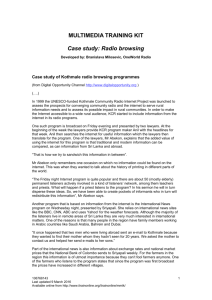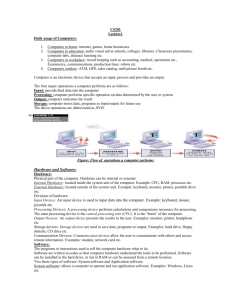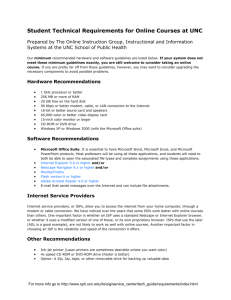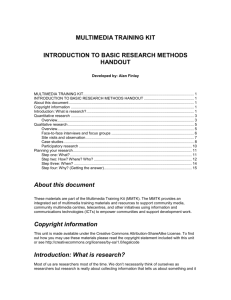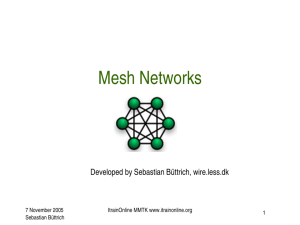internet basics handout
advertisement
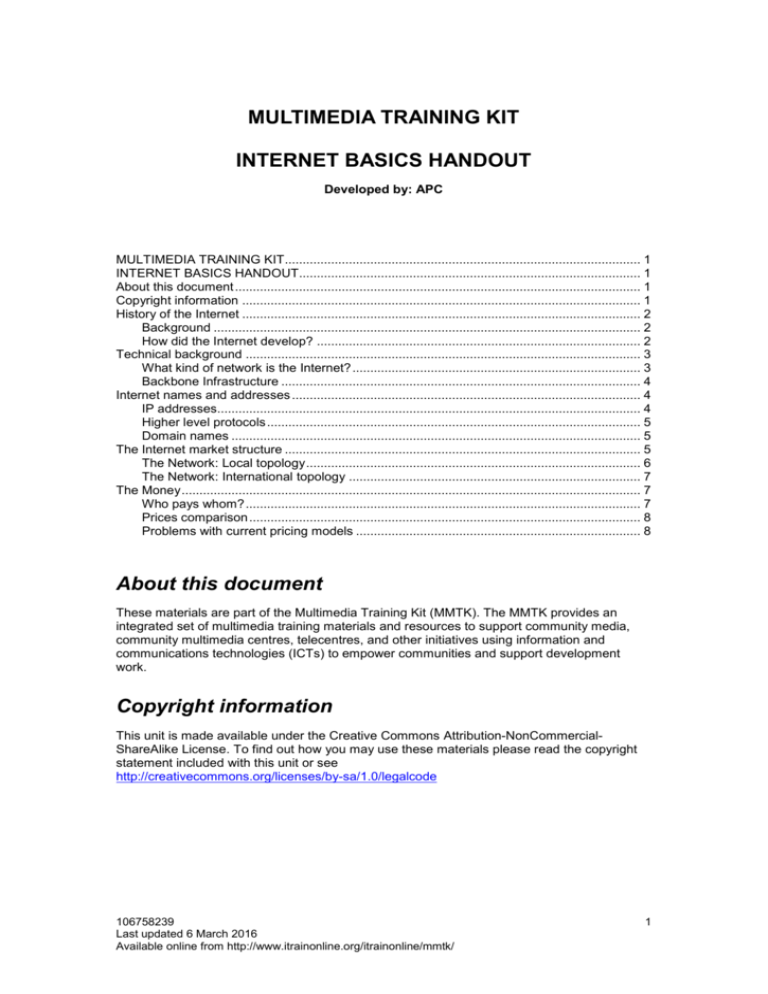
MULTIMEDIA TRAINING KIT INTERNET BASICS HANDOUT Developed by: APC MULTIMEDIA TRAINING KIT .................................................................................................... 1 INTERNET BASICS HANDOUT................................................................................................ 1 About this document .................................................................................................................. 1 Copyright information ................................................................................................................ 1 History of the Internet ................................................................................................................ 2 Background ........................................................................................................................ 2 How did the Internet develop? ........................................................................................... 2 Technical background ............................................................................................................... 3 What kind of network is the Internet? ................................................................................. 3 Backbone Infrastructure ..................................................................................................... 4 Internet names and addresses .................................................................................................. 4 IP addresses....................................................................................................................... 4 Higher level protocols ......................................................................................................... 5 Domain names ................................................................................................................... 5 The Internet market structure .................................................................................................... 5 The Network: Local topology .............................................................................................. 6 The Network: International topology .................................................................................. 7 The Money ................................................................................................................................. 7 Who pays whom? ............................................................................................................... 7 Prices comparison .............................................................................................................. 8 Problems with current pricing models ................................................................................ 8 About this document These materials are part of the Multimedia Training Kit (MMTK). The MMTK provides an integrated set of multimedia training materials and resources to support community media, community multimedia centres, telecentres, and other initiatives using information and communications technologies (ICTs) to empower communities and support development work. Copyright information This unit is made available under the Creative Commons Attribution-NonCommercialShareAlike License. To find out how you may use these materials please read the copyright statement included with this unit or see http://creativecommons.org/licenses/by-sa/1.0/legalcode 106758239 Last updated 6 March 2016 Available online from http://www.itrainonline.org/itrainonline/mmtk/ 1 History of the Internet Background When most people think of the Internet, they think of a computer screen with pretty text and images- the World Wide Web pages we are so used to. But the Internet is not the same as a web page. It predates the Web, and has many other functions. What with email, newsgroups, videoconferences, chats, voice over IP, p2p networks, etc. (none of them web-based), the list is huge and getting bigger. The internet began in the USA during the Cold War. When the Soviet Union placed the Sputnik satellite into space in 1957, the US military was shocked, which led to the creation of the Advanced Research Projects Agency (ARPA). One of ARPA’s projects was to investigate large-scale networking of computers, especially to allow collaboration between scientists and researchers. It was to be a decentralised network, without a central focus or control point, so that if one node in the network failed, the others could take over its role. The decentralised nature of the internet is said to have been inspired by the idea of surviving a nuclear attack. A centralised communication system could be put out of action easily with a missile, but if all the points on the network could replace the destroyed node, if none was essential to the functioning of the network as a whole, then the system would be able to withstand at least limited damage. In fact, the initial motivation was more how to avoid centralised control, and the need to stimulate cooperation amongst researchers. And it was to be open to connection with other systems via publicly available standards. How did the Internet develop? The Internet began in 1969, and it has had three main stages of development: military (1969 - 1980’s), academic (1980’s - 1991) and commercial (1991 - ). Military stage The Internet grew out of research done by the Advanced Research Projects Agency (ARPA), an organisation sponsored by the United States Department of Defense. The objective of the Internet’s grandfather – ARPANET – was to link geographically distant computers to allow remote access and sharing of data. One of the design criteria for the ARPANET network was that it should have no single point of failure. Contrary to popular opinion, the Internet was not designed to withstand a nuclear attack, but it was designed to withstand significant failure. Consequences of this stage: the Internet is a highly decentralised network. Because the pricing model for the early network was to charge for computing resources and not for network traffic, the main protocol used by the Internet – TCP/IP – does not contain any cost information, making charging for Internet traffic complex. The network developed by ARPA – ARPANET– was born in late 1969. ARPANET was a packet-based system and its descendant – the Internet – is also a packet-based network. Information travelling on packet networks has multiple routes to its destination, which means that these networks have no single point of failure. (Remember, this was a key design criteria.) The initial protocol used for the transmission of packets across the ARPANET was called the Network Control Protocol (NCP). The current protocol – Transmission Control Protocol / Internet Protocol (TCP/IP) was adopted in 1973 and has been used ever since. 106758239 Last updated 6 March 2016 Available online from http://www.itrainonline.org/itrainonline/mmtk/ 2 Commercial Stage Beginning in the late 1980’s and leading in to the early 90’s, the operation of the Internet moved out of the academic sector into the commercial sector. Sections of the NSFNet were taken over by backbone Internet access providers and as the restrictions on commercial traffic were lifted, business use and users of the Internet quickly began to outnumber research user. Consequences of this stage: Very rapid growth of the network and in the number of users. Competition has driven down the cost of access to the network. Technical background What kind of network is the Internet? Structure of the Internet Looking at the development of the word “Internet” gives some insight into the nature of the Internet. Just as the word ‘network’ is used to describe a number of interconnected computers, so the word ‘internet’ is used to describe a number interconnected networks. The word ‘Internet’ (with a capital letter) is used to mean the global set of internet. Although the Internet is often considered to be a public network, it is actually made up of many thousands of independent private networks, all exchanging traffic by common agreement using public standards. Circuit-based network Some networks – for example the telephone network – are circuit based. This means that a connection has to be set-up between the originator of a signal and the recipient before information can be sent. This connection must be maintained for the duration of the communication. If it is broken, the flow of information is interrupted. Example: If a merchant in Singapore telephones calls a bank in London, a connection is established between them. If one of the cables making up this connection fails, the call will be dropped. Packet-based network Unlike circuit-based networks, packet-based networks have no single points of failure. Data is broken up into small packets and can travel to its destination by multiple routers. Packets can even be lost entirely, and are simply resent. Also unlike circuit-based networks, packet networks have no dedicated end-to-end connection. Because there are no permanent connections, packet-based networks are characterised by unpredictable routing. Packets can travel along multiples routes to the same destination. Example: Posting a parcel at the post office is similar to sending a packet over a network. As long as the parcel is clearly labelled (with the destination address, and sometimes a return address), the sender does not need to know exactly which route it will travel. Depending on the availability of vehicles and transport, the parcel could take more than one route to its destination. 106758239 Last updated 6 March 2016 Available online from http://www.itrainonline.org/itrainonline/mmtk/ 3 The Internet is a packet-based network. This means that Internet traffic can take many different routes to its destination. This has an impact on the economics of the Internet and also makes Internet content difficult to control and regulate. Backbone Infrastructure Copper cable End-users are usually connected to the Internet via copper cable – often a telephone line. These lines connect to exchanges, which are in turn connected to each other by higher speed lines. There is a limit to the capacity a copper pair can handle. Fibre-optic cable Glass fibre cable runs at much higher speeds than copper. Large fibre-optic undersea cables connect the Internet in different continents. Satellite Satellites provide an important role in providing Internet connectivity. Geostationary satellites orbit the earth in a fixed position over the equator while a low-earth-orbit (LEO) satellites revolved slowly around the earth. Users are passed from one LEO to another and do not require complicated antennas. Very Small Aperture Terminals (VSATs) are small satellite systems designed for home and business use. Broadband services Broadband is a term used to refer to higher speed data services such as video-conferencing or video streaming. It is a fairly vaguely defined word. Examples of ‘broadband’ services include Digital Subscriber Line (DSL) and Cable TV. Internet names and addresses There are technical standards that allow the internet to function as a decentralised network of interconnected computers, these are the internet names and addresses. The TCP protocol defines the way data is broken down into manageable chunks, or packets, which are then sent individually through the internet. Imagine a large letter is broken up into separate pages. Each page is put into its own envelope and then into the post box. When they reach their common destination, they are put back together to create the original file or piece of data. This is more efficient than, for example, a continuous flow of data, because if one of the packages is lost, it can be re-requested and sent without having to re-send all the data, causing less errors and less wasted time. IP addresses The IP addresses used to identify devices connected to the Internet consist of four 8-bit numbers (0-255) written in the form xx.xx.xx.xx (e.g.. 160.124.112.23). Each device on the Internet must have a unique IP number so that packets destined for that address can be directed to that particular device (but see NAT below). Some ranges of IP addresses are reserved for special purposes. Mostly because of fairly liberal distribution of IP numbers during the early development of the Internet, we are gradually running out of IP addresses. But while most of the Internet still uses IP version 4, IP version 6 is gradually being implemented. IP v. 6 uses eight 8-bit numbers for its addresses. With 18,446,744,073,709,551,616 (18 billion billion!) possible addresses, there is unlikely to be a scarcity of IP6 numbers for a long time. 106758239 Last updated 6 March 2016 Available online from http://www.itrainonline.org/itrainonline/mmtk/ 4 An increasing number of private networks perform Network Address Translation (NAT). All incoming traffic travels though a gateway machine with a single IP address. This machine does some address translation and determines which machine inside the network each packet is destined for. As well as conserving IP addresses, NAT can provide some security benefits. Higher level protocols TCP and IP are the basic protocols for moving packets of data around the Internet, but that is all they do. Higher layer protocols are used for other applications. Examples include: Telnet and SSH which allow remote login access Hypertext Transfer Protocol (HTTP) – used for web pages SHTTP is a secure version of HTTP Simple Mail Transfer Protocol (SMTP) – used for e-mail transport File Transfer Protocol (FTP) – used for file sharing Border Gateway Protocol (BGP) – used for routing Domain names As we’ve already discussed, computers on the Internet are identified by IP numbers (e.g.. 160.124.112.23). Most people are more familiar with domain names – google.com or amazon.com. The domain name system was introduced to make it easier for humans using the network to identify host machines (like web servers). Types of domain names There are several types of top-level domains (TLDs): Generic TLDs (gTLDs): Use of these domains is open to all. Second level registrations are done on a first come, first served basis for a small fee. (Examples: .com, .net, .org.) Country code TLDs (ccTLDs): Each nation is assigned a two-letter ccTLD, based on the ISO-3166 MA code system. (Examples: .uk, .za, .jp.) Different countries administer their ccTLDs in different ways, but most countries split their domains into several second level domains (Examples: .co.uk, .ngo.za.) Special domain names Use of some TLDs is limited, including .gov for the US Government, .mil for the US military, and .int for organisations created by international treaty. The Internet market structure To connect to the internet, you can be on a local network which is connected already, as in a library or university, or have a special cable which connects you directly, such as a leased line (a special cable leased from the telecommunications company which provides fast but expensive access) or a cable TV connection, or have a contract with a company which provides a satellite connection, or through a local wireless connection point. Most people however, connect via the telephone system with a modem or ADSL, using their telephone wire (via the ‘local loop’ between the telephone and the telephone exchange) because it is cheaper and more readily available. In general, the faster the connection, the more it costs. When you connect via a commercial link, you do so through a company or Internet Service Provider (ISP), which has a permanent connection to the internet and charges you for sharing this connection with hundreds or thousands of other users. The ISP only routes local traffic to a commercial carrier, usually a telecommunications company or a huge ISP, with a further connection to the main highways of the internet, which most people never see. The first of 106758239 Last updated 6 March 2016 Available online from http://www.itrainonline.org/itrainonline/mmtk/ 5 these backbone carriers was NFSNet, back in 1986, but now huge companies, such as UUNet, Sprint, and ATT, run the most important internet infrastructure. They connect to each other through Major Exchange Points (MAPs, MAEs, etc) and in this way the internet extends over the face of the planet. So we have: 1. End users 2. ISPs 3. Carriers 4. Major Exchange Points 5. Backbone carriers The Network: Local topology Role of the telecoms provider This diagram above a typical Internet market structure. Before examining the roles played by each Internet service provider (ISP), it is important to examine the role played by the telecoms provider (or providers). Although ISPs build and operate backbone networks and ultimately provide Internet access to end-users, their networks build on underlying infrastructure provided by a telco. In addition to these connections, the networks of backbone operators generally also make use of underlying telecoms services – shown in green above. Internet services can be visualised as a layer operating on top of the physical network. When a telco provide ISP-level services as well as providing underlying physical connections, this structure may differ slightly, with less clear boundaries between ISP-level services and telco infrastructure services. 106758239 Last updated 6 March 2016 Available online from http://www.itrainonline.org/itrainonline/mmtk/ 6 Customer – ISP Internet end-users – be they companies with employees using corporate networks or homeusers using dial-up accounts – purchase Internet access from an Internet service provider (ISP). A connection to an ISP might be via a standard voice telephone line (using a modem), or via a number of other methods Asymmetric Digital Subscriber Line: A method of using existing telephone lines to provide dedicated access at speeds of about 512 kbps up to 6 Mbps. Fixed line: Dedicated copper or fibre optic cables provide a permanent connection from the customer to the ISP. Mobile/cellular phones: This is usually a low speed connection, and services may be specially tailored for these speeds (eg. Wireless Application Protocol (WAP) services) Wireless: Wireless radio connections are becoming more common for Internet access. Small community networks can use wireless connections to share a high speed Internet access circuit. Satellite: Satellite tends to be an expensive way to access the Internet, but is feasible in even the most remote geographic locations. The Network: International topology Backbone carriers Over the last few years, the number of large ‘backbone’ operators has declined, with massive consolidation occurring in the market. The remaining backbone ISPs tend to be large international telecomms operators. In exactly the same way that national ISPs interchange traffic at local INXes, so do many backbone operators. Large US exchanges include MAE-West and MAE-East. While traffic has historically been exchanged between ISPs of all sizes connected to an INX, there is a trend towards bilateral peering arrangements only with ISPs of approximately the same magnitude. Smaller operators are required to pay some form of interconnection charges or transit fees for their traffic. The financial value of traffic is largely based on the perceived value of that traffic to each of the two parties involved. Higher-level (backbone) ISPs often exchange traffic with each other at no cost, but charge small ISPs for the same service. The Money Who pays whom? Unlike many other telecommunications markets, which have established economic principles, the economics of the Internet access market form a constantly shifting and high variable system. The customer pays the ISP a monthly subscription charge. Some billing models have a fixed price for unlimited traffic. Other models are based on traffic, or have a traffic-based pricing component for heavy usage. In some economies, ISPs offer free services. These ISPs either generate revenue from alternative sources (see next slide), or gain some other benefit – possibly a marketing advantage – by offering free Internet access. The customer also pays the local telco line rental charges and/or metered call charges. This depends on the nature of the connection, as discussed earlier. (Sometimes the local telco is also the ISP.) The high cost of local calls is the biggest barrier to increased Internet use in developing countries. 106758239 Last updated 6 March 2016 Available online from http://www.itrainonline.org/itrainonline/mmtk/ 7 The ISP pays the telco for the rental of telephone lines to connect to its modem ports. Most ISPs also pay telcos for long-distance fixed lines and international connections. The ISP pays another ISP a fee for the exchange of traffic. In the case of smaller ISPs connecting to upstream ISPs, one ISP is a customer of the other. In the case of mutual peering agreements, there might be no fee – traffic is exchanged freely. Alternatively, there could be a fee based on the shared cost of a peering link, or a share of the cost of running an Internet exchange. ISP to ISP payments could also be for ‘virtual’ ISP services. This is where one ISP provides the underlying Internet access infrastructure for the customers of the other, and the second ISP simply handles billing and customer support. The telco pays another telco a call settlement fee for any telephone traffic delivered to that telco’s network. There may also be telco-to-telco co-location charges, traffic transit charges or other forms of interconnection charges. Prices comparison The high price of access to the Internet in developing countries, as compared to OECD countries: Telecentres can provide access to the internet in public ways that would not be financially possible for individuals. The cost of a computer in many African countries is more than the average annual wage. Therefore public provision is the only feasible option if many people are not to be excluded from the ‘Information Age’. Problems with current pricing models Perception: ‘Everyone pays the United States’ One view: When other countries connect to the US-portion of the Internet, they bear the entire cost of the connection from their local networks to the United States. While the connecting country gains the benefit of access to United States’ content, the United States also gains the 106758239 Last updated 6 March 2016 Available online from http://www.itrainonline.org/itrainonline/mmtk/ 8 benefit of access to network content in the connecting country. It seems fair that some portion of the costs should be borne by the US operators. Alternative view: The United States actually provides a cost-effective transit system between the connection country and networks in almost 250 other countries. The cost of connecting to the US is much lower than the cost of connecting separately to these countries. Were an international settlement system imposed on the Internet, it would simply force US operators to increase prices to international customers to cover the cost of the interconnection fees now in place with other countries. Higher levels of competition in telecoms markets are likely to be more effective in reducing Internet access prices to consumers then the introduction of an international Internet balance of payments system. 106758239 Last updated 6 March 2016 Available online from http://www.itrainonline.org/itrainonline/mmtk/ 9
